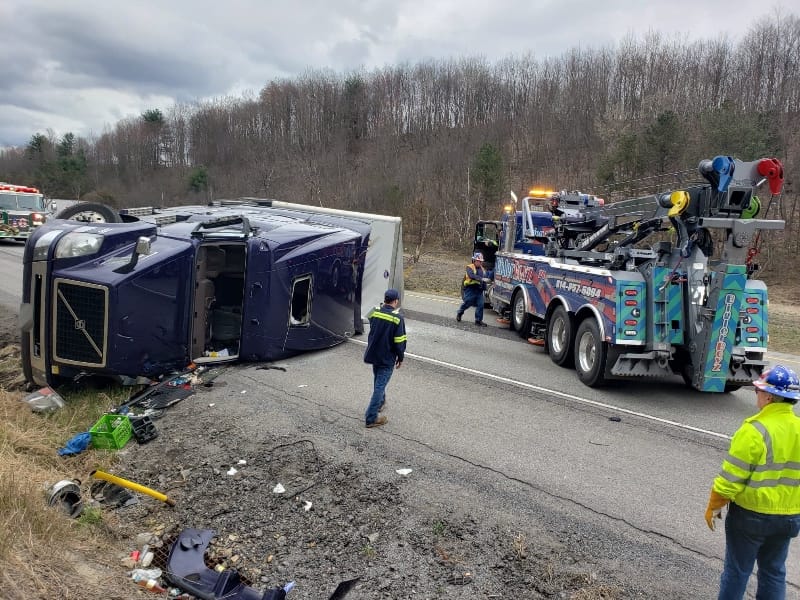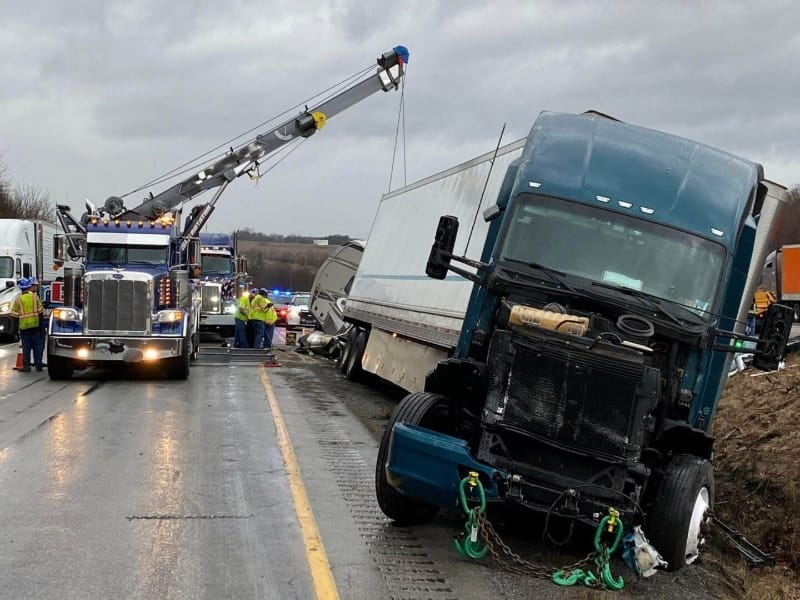A Call That Can’t Wait
We’ve had plenty of middle-of-the-night calls, but nothing quite matches the urgency of a semi sprawled sideways across the interstate. The moment that call comes in, we know we’re dealing with more than a broken-down vehicle. We’re dealing with gridlock, safety risks, and lost time for hundreds of drivers. I-80 highway towing is as much about moving a truck, as it is about restoring the flow of one of the country’s busiest transportation corridors.
The pressure is high, but so are the stakes. Every minute that a lane is blocked, the backup grows, and so does the risk of secondary crashes. Here’s how we tackle these situations, step by step, to get things moving again.

Fast Decisions in Slow Traffic
When we arrive, the first thing we do is size up the scene. Is the trailer loaded or empty? Is fuel leaking? Is traffic still crawling past in another lane or is the whole interstate shut down?
Sometimes the semi has jackknifed across all lanes. Other times it’s off the shoulder but partially hanging into traffic. Each case calls for a different strategy, but our mindset is always the same: clear the road quickly and safely without making the situation worse.
Safety First, Then Everything Else
Before we even touch the rig, we secure the scene:
- We coordinate with highway patrol to shut lanes or direct traffic.
- We set out cones, flares, and lights to protect ourselves and others.
- We check for fluid spills, compromised cargo, or unstable equipment.
Only once we’re sure it’s safe do we start working. Time is critical, but we can’t afford to cut corners.
The Tools That Keep the Interstate Running
A semi-blocking incident on I-80 is never a one-size-fits-all situation. We bring out the heavy wreckers, air cushions, straps, winches, and even forklifts when needed. The equipment we use depends entirely on the load, the truck’s position, and what’s at risk around it.
Sometimes it’s a simple winch-out. Other times, we have to upright a fully loaded trailer that’s tipped and spilled cargo all over the median. If hazardous materials are involved, we also coordinate with cleanup crews before we can proceed.
Here’s a breakdown of some scenarios we handle with I-80 highway towing:
- Jackknifed tractor-trailers
- Rollovers blocking multiple lanes
- Blowouts that send trucks off-road
- Mechanical failures in dangerous spots
- Lost cargo that needs to be reloaded on site
The Clock Is Always Ticking
Interstate shutdowns affect more than just truckers. Emergency responders, commuters, and commercial fleets all depend on roads like I-80 staying clear. Every time we take on an I-80 highway towing job, we’re racing against time and traffic.
Once we’ve stabilized the vehicle, we either tow it to a safe location or perform on-site recovery to get lanes back open. This might mean:
- Splitting the cab and trailer for easier movement
- Uprighting with airbags
- Using dual wreckers for tandem lifts
- Coordinating with DOT for lane reopening
Even after we’ve cleared the major obstruction, there’s often debris left behind that needs clearing before traffic can fully resume.
What Every Driver Should Know
Highway incidents are unpredictable, but there are things you can do to stay safe and help crews do their job faster:
- Move over if you see flashing lights.
- Stay in your vehicle unless instructed otherwise.
- Don’t try to pass a scene unless directed.
- Be patient — we’re working to clear the way as quickly as possible.
I-80 highway towing involves more than hooks and cables. It’s about judgment calls, rapid coordination, and doing tough work under pressure.

Bigler Boyz: Your I-80 Highway Towing Experts
Every I-80 highway towing operation affects more than just the truck we’re pulling. We’re making the road safer, preventing additional accidents, and keeping commerce moving across the country. We take that responsibility seriously — day, night, rain, or snow.
Next time you pass a I-80 highway towing scene, just remember: we’re not just pulling trucks. We’re pulling everything back to normal. And for us, there’s no such thing as just another call.

